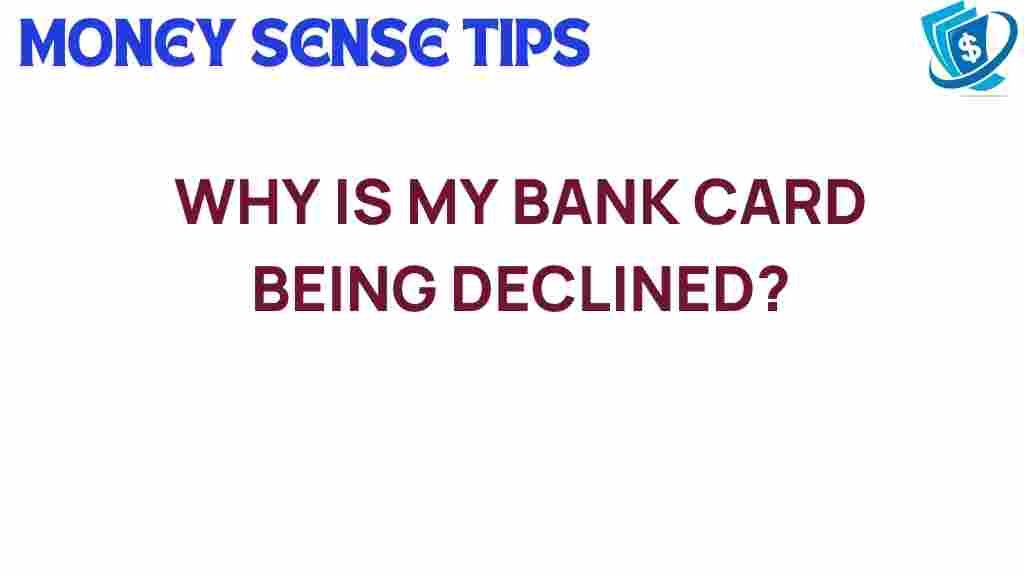What to Do When Your Bank Card Is Declined
Experiencing a declined transaction can be frustrating and embarrassing, especially when you’re trying to make a purchase. Whether you’re at the grocery store, dining at a restaurant, or shopping online, the moment your bank card is declined can leave you feeling anxious. Understanding the reasons behind declined transactions and knowing how to troubleshoot them is essential for managing your finances effectively. In this article, we will unravel the mystery of declined transactions, provide financial tips, and discuss troubleshooting steps to help you navigate these payment issues.
Understanding Declined Transactions
When your bank card is declined, it means the transaction could not be completed for some reason. This can happen with both debit and credit cards and may be due to a variety of factors. Here are some common reasons for declined transactions:
- Insufficient Funds: For debit cards, if your account balance is lower than the transaction amount, the payment will be declined.
- Credit Limit Exceeded: If you are using a credit card, a declined transaction may occur if you have reached or exceeded your credit limit.
- Banking Errors: Sometimes, banks may mistakenly flag legitimate transactions as fraudulent, leading to a decline.
- Expired Card: If your card has expired, it will be declined at the point of sale.
- Incorrect Information: Inputting incorrect information, such as the wrong PIN or CVV, can lead to a declined transaction.
- Card Security Measures: Banks often put security measures in place to protect consumers, which might block transactions that seem suspicious.
Now that we understand some of the common reasons behind declined transactions, let’s explore what steps to take when your bank card is declined.
Step-by-Step Process: What to Do When Your Bank Card Is Declined
When faced with a declined transaction, follow these steps to resolve the issue:
1. Remain Calm
The first step is to stay calm. It can be embarrassing, but remember that declined transactions happen to everyone at some point.
2. Check Your Balance
If you’re using a debit card, check your account balance to ensure you have enough funds for the transaction. You can do this through your bank’s mobile app or website.
3. Review Your Credit Limit
For credit card users, verify that you have not exceeded your credit limit. If you are close to your limit, consider paying down some of your balance to ensure future transactions go through smoothly.
4. Verify Card Details
Make sure you’re entering the correct card details. Check the expiration date, CVV, and your PIN if applicable. Any discrepancy can lead to a declined transaction.
5. Contact Your Bank
If you’ve confirmed your balance and details, but your card is still declined, contact your bank. They can provide insights into why the transaction was declined and help you resolve any issues, such as potential fraud alerts.
6. Try Another Payment Method
If the issue persists and you need to complete your purchase, consider using an alternative payment method, such as cash or another card.
7. Check for Card Security Alerts
Many banks have security measures in place to protect against fraud. If your transaction seems suspicious, your bank may have declined it as a precaution. Check your bank’s app or website for any alerts regarding your card usage.
8. Update Your Card Information
If your card has expired or you’ve recently changed banks, make sure to update your payment information on any online accounts or services you use.
Troubleshooting Tips for Declined Transactions
Here are some troubleshooting tips to help you prevent and handle declined transactions effectively:
- Keep Track of Your Spending: Regularly monitor your account balances and credit limits to avoid unexpected declines.
- Set Up Alerts: Many banks offer transaction alerts. Set up notifications for low balances and credit limit alerts.
- Use Mobile Banking: Utilize your bank’s mobile app to quickly check your balance and transaction history.
- Know Your Bank’s Policies: Familiarize yourself with your bank’s transaction policies, including daily withdrawal limits and international transaction fees.
- Secure Your Card: Always keep your bank card secure. Report any lost or stolen cards immediately to prevent unauthorized transactions.
- Consider Automatic Payments: Set up automatic payments for regular bills to avoid missed payments that could lead to declined transactions.
Common Consumer Advice for Managing Bank Cards
Here are some valuable consumer advice tips to keep in mind when using bank cards:
- Use Strong Passwords: Protect your online banking accounts with strong, unique passwords to enhance card security.
- Enable Two-Factor Authentication: Whenever possible, enable two-factor authentication for an added layer of security.
- Regularly Update Your Information: Keep your contact information updated with your bank to receive important alerts and updates.
- Be Cautious with Public Wi-Fi: Avoid accessing sensitive banking information over public Wi-Fi networks to prevent fraud.
- Review Statements: Regularly review your bank statements for unauthorized transactions.
Conclusion
Having your bank card declined can be inconvenient, but understanding the reasons behind declined transactions can help you navigate these situations with ease. By following the steps outlined in this article, you can troubleshoot effectively and minimize the chances of future payment issues. Remember to keep your bank cards secure, monitor your accounts, and stay informed about your bank’s policies. For more consumer advice and financial tips, you can visit this resource.
Should you encounter persistent issues or have concerns about your bank card security, always reach out to your bank for assistance. With the right knowledge and tools, you can ensure smoother transactions and maintain control over your finances.
For further reading on banking errors and consumer advice, check out this helpful article here.
This article is in the category Services and created by MoneySenseTips Team
